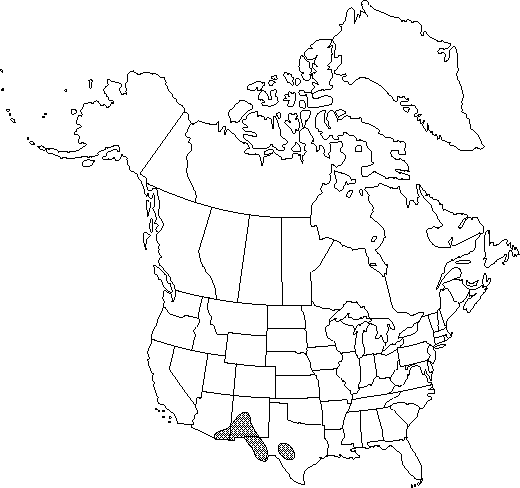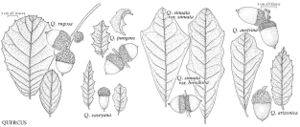Difference between revisions of "Quercus pungens"
Overs. Kongel. Danske Vidensk. Selsk. Forh. Medlemmers Arbeider 1854: 171. 185.
not Q. pungens Gandoger 1890.
FNA>Volume Importer |
FNA>Volume Importer |
||
| Line 27: | Line 27: | ||
}}<!-- | }}<!-- | ||
| − | --><span class="statement" id="st- | + | --><span class="statement" id="st-undefined" data-properties=""><b>Shrubs </b>or moderate-sized trees, evergreen or subevergreen. <b>Bark</b> light brown, papery. <b>Twigs</b> gray, 1-2 mm diam., short velvety-tomentose, glabrate with age. <b>Buds</b> dark red-brown, ca. 2 mm, sparsely pubescent. <b>Leaves</b>: petiole to 10 mm. <b>Leaf</b> blade elliptic to oblong, 10-40(-90) × 10-20(-40) mm, rather thick, leathery, stiff, base rounded or minutely cordate, very rarely cuneate, margins regularly undulate-crisped, not revolute, coarsely toothed or incised with acute teeth or spinose lobes, secondary veins 5-8(-14) on each side, usually branched before passing into teeth, apex acute or obtuse, rarely rounded, spine-tipped; surfaces abaxially canescent, usually densely stellate-pubescent, and mixed with stiff, harsh, stellate hairs, often sandpapery to touch, rarely glabrate, adaxially yellowish green, glossy, usually rough and sandpapery because of minute, persistent hair bases, rarely glabrate. <b>Acorns</b> subsessile or on peduncle to 3 mm; cup shallowly to deeply cup-shaped or turbinate, to 8 mm deep × 13 mm wide, covering ca. 1/4 nut, margin thin, scales reddish brown, moderately tuberculate or keeled, densely gray-tomentose; nut light brown, broadly ovoid to subcylindric, to 10 × 10 mm, apex rounded to subacute, glabrous. <b>Cotyledons</b> distinct.</span><!-- |
-->{{Treatment/Body | -->{{Treatment/Body | ||
| Line 33: | Line 33: | ||
|habitat=On dry limestone or igneous slopes, usually in oak, pinyon, and juniper woodlands, chaparral, and sometimes descending into desert vegetation | |habitat=On dry limestone or igneous slopes, usually in oak, pinyon, and juniper woodlands, chaparral, and sometimes descending into desert vegetation | ||
|elevation=800-2000 m | |elevation=800-2000 m | ||
| − | |distribution=Ariz.;N.Mex.;Tex.;Mexico (Chihuahua and Coahuila) | + | |distribution=Ariz.;N.Mex.;Tex.;Mexico (Chihuahua and Coahuila). |
|discussion=<p>Numerous populations appear to be hybrid swarms between Quercus pungens and Q. vaseyana, which is sometimes treated as a variety of Q. pungens. No other evidence for a close relationship exists for these two species, and such a treatment risks erecting a polyphyletic assemblage. To the west and south within the range of Q. pungens no indication of introgression exists, and the two species are strikingly different and easily separable. I interpret the contact as secondary.</p> | |discussion=<p>Numerous populations appear to be hybrid swarms between Quercus pungens and Q. vaseyana, which is sometimes treated as a variety of Q. pungens. No other evidence for a close relationship exists for these two species, and such a treatment risks erecting a polyphyletic assemblage. To the west and south within the range of Q. pungens no indication of introgression exists, and the two species are strikingly different and easily separable. I interpret the contact as secondary.</p> | ||
|tables= | |tables= | ||
| Line 53: | Line 53: | ||
|habitat=On dry limestone or igneous slopes, usually in oak, pinyon, and juniper woodlands, chaparral, and sometimes descending into desert vegetation | |habitat=On dry limestone or igneous slopes, usually in oak, pinyon, and juniper woodlands, chaparral, and sometimes descending into desert vegetation | ||
|elevation=800-2000 m | |elevation=800-2000 m | ||
| − | |distribution=Ariz.;N.Mex.;Tex.;Mexico (Chihuahua and Coahuila) | + | |distribution=Ariz.;N.Mex.;Tex.;Mexico (Chihuahua and Coahuila). |
|reference=None | |reference=None | ||
|publication title=Overs. Kongel. Danske Vidensk. Selsk. Forh. Medlemmers Arbeider;not Q. pungens Gandoger | |publication title=Overs. Kongel. Danske Vidensk. Selsk. Forh. Medlemmers Arbeider;not Q. pungens Gandoger | ||
|publication year=;1890 | |publication year=;1890 | ||
|special status=Selected by author to be illustrated | |special status=Selected by author to be illustrated | ||
| − | |source xml=https://jpend@bitbucket.org/aafc-mbb/fna- | + | |source xml=https://jpend@bitbucket.org/aafc-mbb/fna-data-curation.git/src/9216fc802291cd3df363fd52122300479582ede7/coarse_grained_fna_xml/V3/V3_895.xml |
|genus=Quercus | |genus=Quercus | ||
|section=Quercus sect. Quercus | |section=Quercus sect. Quercus | ||
|species=Quercus pungens | |species=Quercus pungens | ||
| − | |||
| − | |||
| − | |||
| − | |||
| − | |||
| − | |||
| − | |||
| − | |||
| − | |||
| − | |||
| − | |||
| − | |||
| − | |||
| − | |||
| − | |||
| − | |||
| − | |||
| − | |||
| − | |||
| − | |||
| − | |||
| − | |||
| − | |||
| − | |||
| − | |||
| − | |||
| − | |||
| − | |||
| − | |||
| − | |||
| − | |||
| − | |||
| − | |||
| − | |||
| − | |||
| − | |||
| − | |||
| − | |||
| − | |||
| − | |||
| − | |||
| − | |||
| − | |||
| − | |||
| − | |||
| − | |||
| − | |||
| − | |||
| − | |||
| − | |||
| − | |||
| − | |||
| − | |||
| − | |||
| − | |||
| − | |||
}}<!-- | }}<!-- | ||
-->[[Category:Treatment]][[Category:Quercus sect. Quercus]] | -->[[Category:Treatment]][[Category:Quercus sect. Quercus]] | ||
Revision as of 14:53, 27 July 2019
Shrubs or moderate-sized trees, evergreen or subevergreen. Bark light brown, papery. Twigs gray, 1-2 mm diam., short velvety-tomentose, glabrate with age. Buds dark red-brown, ca. 2 mm, sparsely pubescent. Leaves: petiole to 10 mm. Leaf blade elliptic to oblong, 10-40(-90) × 10-20(-40) mm, rather thick, leathery, stiff, base rounded or minutely cordate, very rarely cuneate, margins regularly undulate-crisped, not revolute, coarsely toothed or incised with acute teeth or spinose lobes, secondary veins 5-8(-14) on each side, usually branched before passing into teeth, apex acute or obtuse, rarely rounded, spine-tipped; surfaces abaxially canescent, usually densely stellate-pubescent, and mixed with stiff, harsh, stellate hairs, often sandpapery to touch, rarely glabrate, adaxially yellowish green, glossy, usually rough and sandpapery because of minute, persistent hair bases, rarely glabrate. Acorns subsessile or on peduncle to 3 mm; cup shallowly to deeply cup-shaped or turbinate, to 8 mm deep × 13 mm wide, covering ca. 1/4 nut, margin thin, scales reddish brown, moderately tuberculate or keeled, densely gray-tomentose; nut light brown, broadly ovoid to subcylindric, to 10 × 10 mm, apex rounded to subacute, glabrous. Cotyledons distinct.
Phenology: Flowering spring.
Habitat: On dry limestone or igneous slopes, usually in oak, pinyon, and juniper woodlands, chaparral, and sometimes descending into desert vegetation
Elevation: 800-2000 m
Distribution

Ariz., N.Mex., Tex., Mexico (Chihuahua and Coahuila).
Discussion
Numerous populations appear to be hybrid swarms between Quercus pungens and Q. vaseyana, which is sometimes treated as a variety of Q. pungens. No other evidence for a close relationship exists for these two species, and such a treatment risks erecting a polyphyletic assemblage. To the west and south within the range of Q. pungens no indication of introgression exists, and the two species are strikingly different and easily separable. I interpret the contact as secondary.
Selected References
None.
